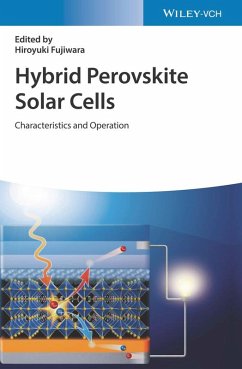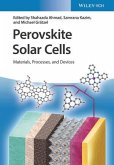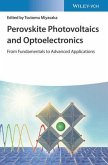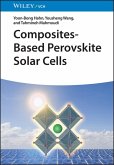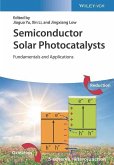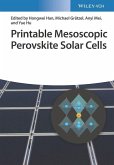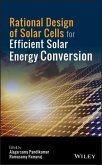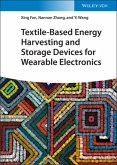Hybrid Perovskite Solar Cells
Characteristics and Operation
Herausgegeben:Fujiwara, Hiroyuki
Hybrid Perovskite Solar Cells
Characteristics and Operation
Herausgegeben:Fujiwara, Hiroyuki
- Gebundenes Buch
- Merkliste
- Auf die Merkliste
- Bewerten Bewerten
- Teilen
- Produkt teilen
- Produkterinnerung
- Produkterinnerung
Unparalleled coverage of the most vibrant research field in photovoltaics: perovskites! The handbook provides a comprehensive, tutorial-style overview of the subject area for further advancing research activities, with in-depth knowledge directly applicable in the lab.
Andere Kunden interessierten sich auch für
![Perovskite Solar Cells Perovskite Solar Cells]() Perovskite Solar Cells182,00 €
Perovskite Solar Cells182,00 €![Perovskite Photovoltaics and Optoelectronics Perovskite Photovoltaics and Optoelectronics]() Perovskite Photovoltaics and Optoelectronics172,00 €
Perovskite Photovoltaics and Optoelectronics172,00 €![Composites-Based Perovskite Solar Cells Composites-Based Perovskite Solar Cells]() Yoon-Bong HahnComposites-Based Perovskite Solar Cells118,79 €
Yoon-Bong HahnComposites-Based Perovskite Solar Cells118,79 €![Semiconductor Solar Photocatalysts Semiconductor Solar Photocatalysts]() Semiconductor Solar Photocatalysts182,00 €
Semiconductor Solar Photocatalysts182,00 €![Printable Mesoscopic Perovskite Solar Cells Printable Mesoscopic Perovskite Solar Cells]() Printable Mesoscopic Perovskite Solar Cells97,99 €
Printable Mesoscopic Perovskite Solar Cells97,99 €![Rational Design of Solar Cells for Efficient Solar Energy Conversion Rational Design of Solar Cells for Efficient Solar Energy Conversion]() Rational Design of Solar Cells for Efficient Solar Energy Conversion192,99 €
Rational Design of Solar Cells for Efficient Solar Energy Conversion192,99 €![Textile-Based Energy Harvesting and Storage Devices for Wearable Electronics Textile-Based Energy Harvesting and Storage Devices for Wearable Electronics]() Xing FanTextile-Based Energy Harvesting and Storage Devices for Wearable Electronics113,99 €
Xing FanTextile-Based Energy Harvesting and Storage Devices for Wearable Electronics113,99 €-
-
-
Unparalleled coverage of the most vibrant research field in photovoltaics: perovskites! The handbook provides a comprehensive, tutorial-style overview of the subject area for further advancing research activities, with in-depth knowledge directly applicable in the lab.
Produktdetails
- Produktdetails
- Verlag: Wiley-VCH
- Artikelnr. des Verlages: 1134729 000
- 1. Auflage
- Seitenzahl: 588
- Erscheinungstermin: November 2021
- Englisch
- Abmessung: 250mm x 175mm x 34mm
- Gewicht: 1316g
- ISBN-13: 9783527347292
- ISBN-10: 3527347291
- Artikelnr.: 61427468
- Herstellerkennzeichnung
- Wiley-VCH GmbH
- Boschstraße 12
- 69469 Weinheim
- wiley.buha@zeitfracht.de
- Verlag: Wiley-VCH
- Artikelnr. des Verlages: 1134729 000
- 1. Auflage
- Seitenzahl: 588
- Erscheinungstermin: November 2021
- Englisch
- Abmessung: 250mm x 175mm x 34mm
- Gewicht: 1316g
- ISBN-13: 9783527347292
- ISBN-10: 3527347291
- Artikelnr.: 61427468
- Herstellerkennzeichnung
- Wiley-VCH GmbH
- Boschstraße 12
- 69469 Weinheim
- wiley.buha@zeitfracht.de
Hiroyuki Fujiwara is Professor in the Department of Electrical, Electronic and Computer Engineering, Gifu University, Japan. Hiroyuki Fujiwara received his Ph.D. degree from Tokyo Institute of Technology. He was a research associate at Pennsylvania State University during 1996-1998. In 1998, he joined the Electrotechnical Laboratory at the Ministry of International Trade and Industry, Japan. During 2007-2008, he was a team leader of Research Center for Photovoltaics, National Institute of Advanced Industrial Science and Technology (AIST) in Japan. Professor Fujiwara has authored and edited six books and has published more than 130 scientific articles. His book on spectroscopic ellipsometry, published by Wiley, has become the most cited book on the topic.
1 Introduction 1
Hiroyuki Fujiwara
1.1 Hybrid Perovskite Solar Cells 1
1.2 Unique Natures of Hybrid Perovskites 4
1.2.1 Notable Characteristics of Hybrid Perovskites 5
1.2.2 Fundamental Properties of MAPbI3 8
1.2.3 Why Hybrid Perovskite Solar Cells Show High Efficiency? 11
1.3 Advantages of Hybrid Perovskite Solar Cells 12
1.3.1 Band Gap Tunability 12
1.3.2 High V oc 13
1.3.3 Low Temperature Coefficient 16
1.4 Challenges for Hybrid Perovskites 16
1.4.1 Requirement of Improved Stability 17
1.4.2 Large-Area Solar Cells 19
1.4.3 Toxicity of Pb and Sn Compounds 20
1.5 Overview of this Book 22 Acknowledgment 23 References 23
2 Overview of Hybrid Perovskite Solar Cells 29
Tsutomu Miyasaka and Ajay K. Jena
2.1 Introduction 29
2.2 Historical Backgrounds of Halide Perovskite Photovoltaics 32
2.3 Semiconductor Properties of Organo Lead Halide Perovskites 34
2.4 Working Principle of Perovskite Photovoltaics 37
2.5 Compositional Design of the Halide Perovskite Absorbers 40
2.6 Strategy for Stabilizing Perovskite Solar Cells 41
2.7 All Inorganic and Lead-Free Perovskites 48
2.8 Development of High-Efficiency Tandem Solar Cells 52
2.9 Conclusion and Perspectives 54
References 55
Part I Characteristics of Hybrid Perovskites 65
3 Crystal Structures 67
Mitsutoshi Nishiwaki, Tatsuya Narikuri, and Hiroyuki Fujiwara
3.1 What Is Hybrid Perovskite? 67
3.2 Structures of Hybrid Perovskite Crystals 68
3.2.1 Crystal Structure of MAPbI3 68
3.2.2 Lattice Parameters of Hybrid Perovskites 71
3.2.3 Secondary Phase Materials 75
3.3 Tolerance Factor 77
3.3.1 Tolerance Factor of Hybrid Perovskites 79
3.3.2 Tolerance Factor of Mixed-Cation Perovskites 82
3.4 Phase Change by Temperature 84
3.5 Refined Structures of Hybrid Perovskites 86
3.5.1 Orientation of Center Cations 86
3.5.2 Relaxation of Center Cations 88 Acknowledgment 89 References 89
4 Optical Properties 91
Hiroyuki Fujiwara, Yukinori Nishigaki, Akio Matsushita, and Taisuke Matsui
4.1 Introduction 91
4.2 Light Absorption in MAPbI3 93
4.2.1 Visible/UV Region 96
4.2.2 IR Region 98
4.2.3 THz Region 99
4.3 Band Gap of Hybrid Perovskites 101
4.3.1 Band Gap Analysis of MAPbI3 101
4.3.2 Band Gap of Basic Perovskites 103
4.3.3 Band Gap Variation in Perovskite Alloys 105
4.4 True Absorption Coefficient of MAPbI3 106
4.4.1 Principles of Optical Measurements 107
4.4.2 Interpretation of a Variation 108
4.5 Universal Rules for Hybrid Perovskite Optical Properties 111
4.5.1 Variation with Center Cation 111
4.5.2 Variation with Halide Anion 112
4.6 Subgap Absorption Characteristics 114
4.7 Temperature Effect on Absorption Properties 116
4.8 Excitonic Properties of Hybrid Perovskites 117
References 119
5 Physical Properties Determined by Density Functional Theory 123
Hiroyuki Fujiwara, Mitsutoshi Nishiwaki, and Yukinori Nishigaki
5.1 Introduction 123
5.2 What Is DFT? 124
5.2.1 Basic Principles 124
5.2.2 Assumptions and Limitations 126
5.3 Crystal Structures Determined by DFT 128
5.3.1 Hybrid Perovskite Structures 128
5.3.2 Organic-Center Cations 131
5.4 Band Structures 132
5.4.1 Band Structures of Hybrid Perovskites 132
5.4.2 Direct-Indirect Issue of Hybrid Perovskite 134
5.4.3 Density of States 139
5.4.4 Effective Mass 140
5.5 Band Gap 141
5.5.1 What Determines Band Gap? 142
5.5.2 Effect of Center Cation 143
5.5.3 Effect of Halide Anion 143
5.6 Defect Physics 144 Acknowledgment 147 References 147
6 Carrier Transport Properties 151
Hiroyuki Fujiwara and Yoshitsune Kato
6.1 Introduction 151
6.2 Carrier Properties of Hybrid Perovskites 153
6.2.1 Self-Doping in Hybrid Perovskites 153
6.2.2 Effect of Carrier Concentration on Mobility 155
6.3 Carrier Mobility of MAPbI3 155
6.3.1 Var
Hiroyuki Fujiwara
1.1 Hybrid Perovskite Solar Cells 1
1.2 Unique Natures of Hybrid Perovskites 4
1.2.1 Notable Characteristics of Hybrid Perovskites 5
1.2.2 Fundamental Properties of MAPbI3 8
1.2.3 Why Hybrid Perovskite Solar Cells Show High Efficiency? 11
1.3 Advantages of Hybrid Perovskite Solar Cells 12
1.3.1 Band Gap Tunability 12
1.3.2 High V oc 13
1.3.3 Low Temperature Coefficient 16
1.4 Challenges for Hybrid Perovskites 16
1.4.1 Requirement of Improved Stability 17
1.4.2 Large-Area Solar Cells 19
1.4.3 Toxicity of Pb and Sn Compounds 20
1.5 Overview of this Book 22 Acknowledgment 23 References 23
2 Overview of Hybrid Perovskite Solar Cells 29
Tsutomu Miyasaka and Ajay K. Jena
2.1 Introduction 29
2.2 Historical Backgrounds of Halide Perovskite Photovoltaics 32
2.3 Semiconductor Properties of Organo Lead Halide Perovskites 34
2.4 Working Principle of Perovskite Photovoltaics 37
2.5 Compositional Design of the Halide Perovskite Absorbers 40
2.6 Strategy for Stabilizing Perovskite Solar Cells 41
2.7 All Inorganic and Lead-Free Perovskites 48
2.8 Development of High-Efficiency Tandem Solar Cells 52
2.9 Conclusion and Perspectives 54
References 55
Part I Characteristics of Hybrid Perovskites 65
3 Crystal Structures 67
Mitsutoshi Nishiwaki, Tatsuya Narikuri, and Hiroyuki Fujiwara
3.1 What Is Hybrid Perovskite? 67
3.2 Structures of Hybrid Perovskite Crystals 68
3.2.1 Crystal Structure of MAPbI3 68
3.2.2 Lattice Parameters of Hybrid Perovskites 71
3.2.3 Secondary Phase Materials 75
3.3 Tolerance Factor 77
3.3.1 Tolerance Factor of Hybrid Perovskites 79
3.3.2 Tolerance Factor of Mixed-Cation Perovskites 82
3.4 Phase Change by Temperature 84
3.5 Refined Structures of Hybrid Perovskites 86
3.5.1 Orientation of Center Cations 86
3.5.2 Relaxation of Center Cations 88 Acknowledgment 89 References 89
4 Optical Properties 91
Hiroyuki Fujiwara, Yukinori Nishigaki, Akio Matsushita, and Taisuke Matsui
4.1 Introduction 91
4.2 Light Absorption in MAPbI3 93
4.2.1 Visible/UV Region 96
4.2.2 IR Region 98
4.2.3 THz Region 99
4.3 Band Gap of Hybrid Perovskites 101
4.3.1 Band Gap Analysis of MAPbI3 101
4.3.2 Band Gap of Basic Perovskites 103
4.3.3 Band Gap Variation in Perovskite Alloys 105
4.4 True Absorption Coefficient of MAPbI3 106
4.4.1 Principles of Optical Measurements 107
4.4.2 Interpretation of a Variation 108
4.5 Universal Rules for Hybrid Perovskite Optical Properties 111
4.5.1 Variation with Center Cation 111
4.5.2 Variation with Halide Anion 112
4.6 Subgap Absorption Characteristics 114
4.7 Temperature Effect on Absorption Properties 116
4.8 Excitonic Properties of Hybrid Perovskites 117
References 119
5 Physical Properties Determined by Density Functional Theory 123
Hiroyuki Fujiwara, Mitsutoshi Nishiwaki, and Yukinori Nishigaki
5.1 Introduction 123
5.2 What Is DFT? 124
5.2.1 Basic Principles 124
5.2.2 Assumptions and Limitations 126
5.3 Crystal Structures Determined by DFT 128
5.3.1 Hybrid Perovskite Structures 128
5.3.2 Organic-Center Cations 131
5.4 Band Structures 132
5.4.1 Band Structures of Hybrid Perovskites 132
5.4.2 Direct-Indirect Issue of Hybrid Perovskite 134
5.4.3 Density of States 139
5.4.4 Effective Mass 140
5.5 Band Gap 141
5.5.1 What Determines Band Gap? 142
5.5.2 Effect of Center Cation 143
5.5.3 Effect of Halide Anion 143
5.6 Defect Physics 144 Acknowledgment 147 References 147
6 Carrier Transport Properties 151
Hiroyuki Fujiwara and Yoshitsune Kato
6.1 Introduction 151
6.2 Carrier Properties of Hybrid Perovskites 153
6.2.1 Self-Doping in Hybrid Perovskites 153
6.2.2 Effect of Carrier Concentration on Mobility 155
6.3 Carrier Mobility of MAPbI3 155
6.3.1 Var
1 Introduction 1
Hiroyuki Fujiwara
1.1 Hybrid Perovskite Solar Cells 1
1.2 Unique Natures of Hybrid Perovskites 4
1.2.1 Notable Characteristics of Hybrid Perovskites 5
1.2.2 Fundamental Properties of MAPbI3 8
1.2.3 Why Hybrid Perovskite Solar Cells Show High Efficiency? 11
1.3 Advantages of Hybrid Perovskite Solar Cells 12
1.3.1 Band Gap Tunability 12
1.3.2 High V oc 13
1.3.3 Low Temperature Coefficient 16
1.4 Challenges for Hybrid Perovskites 16
1.4.1 Requirement of Improved Stability 17
1.4.2 Large-Area Solar Cells 19
1.4.3 Toxicity of Pb and Sn Compounds 20
1.5 Overview of this Book 22 Acknowledgment 23 References 23
2 Overview of Hybrid Perovskite Solar Cells 29
Tsutomu Miyasaka and Ajay K. Jena
2.1 Introduction 29
2.2 Historical Backgrounds of Halide Perovskite Photovoltaics 32
2.3 Semiconductor Properties of Organo Lead Halide Perovskites 34
2.4 Working Principle of Perovskite Photovoltaics 37
2.5 Compositional Design of the Halide Perovskite Absorbers 40
2.6 Strategy for Stabilizing Perovskite Solar Cells 41
2.7 All Inorganic and Lead-Free Perovskites 48
2.8 Development of High-Efficiency Tandem Solar Cells 52
2.9 Conclusion and Perspectives 54
References 55
Part I Characteristics of Hybrid Perovskites 65
3 Crystal Structures 67
Mitsutoshi Nishiwaki, Tatsuya Narikuri, and Hiroyuki Fujiwara
3.1 What Is Hybrid Perovskite? 67
3.2 Structures of Hybrid Perovskite Crystals 68
3.2.1 Crystal Structure of MAPbI3 68
3.2.2 Lattice Parameters of Hybrid Perovskites 71
3.2.3 Secondary Phase Materials 75
3.3 Tolerance Factor 77
3.3.1 Tolerance Factor of Hybrid Perovskites 79
3.3.2 Tolerance Factor of Mixed-Cation Perovskites 82
3.4 Phase Change by Temperature 84
3.5 Refined Structures of Hybrid Perovskites 86
3.5.1 Orientation of Center Cations 86
3.5.2 Relaxation of Center Cations 88 Acknowledgment 89 References 89
4 Optical Properties 91
Hiroyuki Fujiwara, Yukinori Nishigaki, Akio Matsushita, and Taisuke Matsui
4.1 Introduction 91
4.2 Light Absorption in MAPbI3 93
4.2.1 Visible/UV Region 96
4.2.2 IR Region 98
4.2.3 THz Region 99
4.3 Band Gap of Hybrid Perovskites 101
4.3.1 Band Gap Analysis of MAPbI3 101
4.3.2 Band Gap of Basic Perovskites 103
4.3.3 Band Gap Variation in Perovskite Alloys 105
4.4 True Absorption Coefficient of MAPbI3 106
4.4.1 Principles of Optical Measurements 107
4.4.2 Interpretation of a Variation 108
4.5 Universal Rules for Hybrid Perovskite Optical Properties 111
4.5.1 Variation with Center Cation 111
4.5.2 Variation with Halide Anion 112
4.6 Subgap Absorption Characteristics 114
4.7 Temperature Effect on Absorption Properties 116
4.8 Excitonic Properties of Hybrid Perovskites 117
References 119
5 Physical Properties Determined by Density Functional Theory 123
Hiroyuki Fujiwara, Mitsutoshi Nishiwaki, and Yukinori Nishigaki
5.1 Introduction 123
5.2 What Is DFT? 124
5.2.1 Basic Principles 124
5.2.2 Assumptions and Limitations 126
5.3 Crystal Structures Determined by DFT 128
5.3.1 Hybrid Perovskite Structures 128
5.3.2 Organic-Center Cations 131
5.4 Band Structures 132
5.4.1 Band Structures of Hybrid Perovskites 132
5.4.2 Direct-Indirect Issue of Hybrid Perovskite 134
5.4.3 Density of States 139
5.4.4 Effective Mass 140
5.5 Band Gap 141
5.5.1 What Determines Band Gap? 142
5.5.2 Effect of Center Cation 143
5.5.3 Effect of Halide Anion 143
5.6 Defect Physics 144 Acknowledgment 147 References 147
6 Carrier Transport Properties 151
Hiroyuki Fujiwara and Yoshitsune Kato
6.1 Introduction 151
6.2 Carrier Properties of Hybrid Perovskites 153
6.2.1 Self-Doping in Hybrid Perovskites 153
6.2.2 Effect of Carrier Concentration on Mobility 155
6.3 Carrier Mobility of MAPbI3 155
6.3.1 Var
Hiroyuki Fujiwara
1.1 Hybrid Perovskite Solar Cells 1
1.2 Unique Natures of Hybrid Perovskites 4
1.2.1 Notable Characteristics of Hybrid Perovskites 5
1.2.2 Fundamental Properties of MAPbI3 8
1.2.3 Why Hybrid Perovskite Solar Cells Show High Efficiency? 11
1.3 Advantages of Hybrid Perovskite Solar Cells 12
1.3.1 Band Gap Tunability 12
1.3.2 High V oc 13
1.3.3 Low Temperature Coefficient 16
1.4 Challenges for Hybrid Perovskites 16
1.4.1 Requirement of Improved Stability 17
1.4.2 Large-Area Solar Cells 19
1.4.3 Toxicity of Pb and Sn Compounds 20
1.5 Overview of this Book 22 Acknowledgment 23 References 23
2 Overview of Hybrid Perovskite Solar Cells 29
Tsutomu Miyasaka and Ajay K. Jena
2.1 Introduction 29
2.2 Historical Backgrounds of Halide Perovskite Photovoltaics 32
2.3 Semiconductor Properties of Organo Lead Halide Perovskites 34
2.4 Working Principle of Perovskite Photovoltaics 37
2.5 Compositional Design of the Halide Perovskite Absorbers 40
2.6 Strategy for Stabilizing Perovskite Solar Cells 41
2.7 All Inorganic and Lead-Free Perovskites 48
2.8 Development of High-Efficiency Tandem Solar Cells 52
2.9 Conclusion and Perspectives 54
References 55
Part I Characteristics of Hybrid Perovskites 65
3 Crystal Structures 67
Mitsutoshi Nishiwaki, Tatsuya Narikuri, and Hiroyuki Fujiwara
3.1 What Is Hybrid Perovskite? 67
3.2 Structures of Hybrid Perovskite Crystals 68
3.2.1 Crystal Structure of MAPbI3 68
3.2.2 Lattice Parameters of Hybrid Perovskites 71
3.2.3 Secondary Phase Materials 75
3.3 Tolerance Factor 77
3.3.1 Tolerance Factor of Hybrid Perovskites 79
3.3.2 Tolerance Factor of Mixed-Cation Perovskites 82
3.4 Phase Change by Temperature 84
3.5 Refined Structures of Hybrid Perovskites 86
3.5.1 Orientation of Center Cations 86
3.5.2 Relaxation of Center Cations 88 Acknowledgment 89 References 89
4 Optical Properties 91
Hiroyuki Fujiwara, Yukinori Nishigaki, Akio Matsushita, and Taisuke Matsui
4.1 Introduction 91
4.2 Light Absorption in MAPbI3 93
4.2.1 Visible/UV Region 96
4.2.2 IR Region 98
4.2.3 THz Region 99
4.3 Band Gap of Hybrid Perovskites 101
4.3.1 Band Gap Analysis of MAPbI3 101
4.3.2 Band Gap of Basic Perovskites 103
4.3.3 Band Gap Variation in Perovskite Alloys 105
4.4 True Absorption Coefficient of MAPbI3 106
4.4.1 Principles of Optical Measurements 107
4.4.2 Interpretation of a Variation 108
4.5 Universal Rules for Hybrid Perovskite Optical Properties 111
4.5.1 Variation with Center Cation 111
4.5.2 Variation with Halide Anion 112
4.6 Subgap Absorption Characteristics 114
4.7 Temperature Effect on Absorption Properties 116
4.8 Excitonic Properties of Hybrid Perovskites 117
References 119
5 Physical Properties Determined by Density Functional Theory 123
Hiroyuki Fujiwara, Mitsutoshi Nishiwaki, and Yukinori Nishigaki
5.1 Introduction 123
5.2 What Is DFT? 124
5.2.1 Basic Principles 124
5.2.2 Assumptions and Limitations 126
5.3 Crystal Structures Determined by DFT 128
5.3.1 Hybrid Perovskite Structures 128
5.3.2 Organic-Center Cations 131
5.4 Band Structures 132
5.4.1 Band Structures of Hybrid Perovskites 132
5.4.2 Direct-Indirect Issue of Hybrid Perovskite 134
5.4.3 Density of States 139
5.4.4 Effective Mass 140
5.5 Band Gap 141
5.5.1 What Determines Band Gap? 142
5.5.2 Effect of Center Cation 143
5.5.3 Effect of Halide Anion 143
5.6 Defect Physics 144 Acknowledgment 147 References 147
6 Carrier Transport Properties 151
Hiroyuki Fujiwara and Yoshitsune Kato
6.1 Introduction 151
6.2 Carrier Properties of Hybrid Perovskites 153
6.2.1 Self-Doping in Hybrid Perovskites 153
6.2.2 Effect of Carrier Concentration on Mobility 155
6.3 Carrier Mobility of MAPbI3 155
6.3.1 Var

